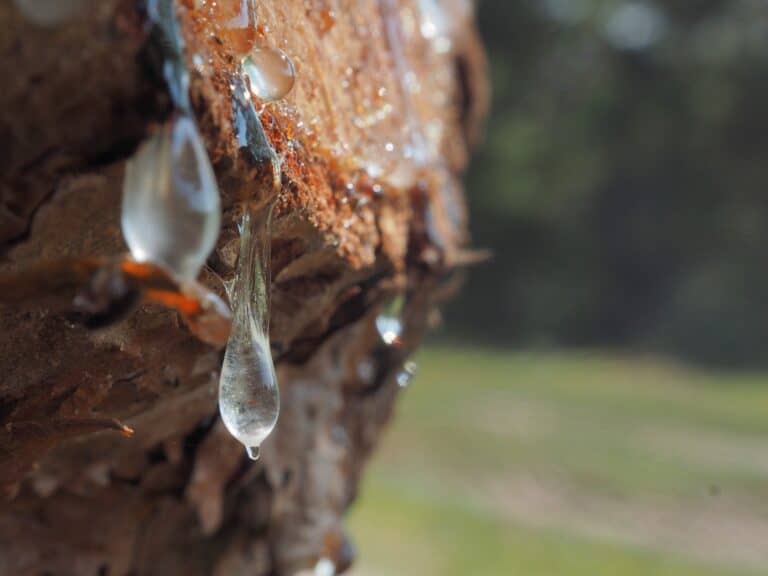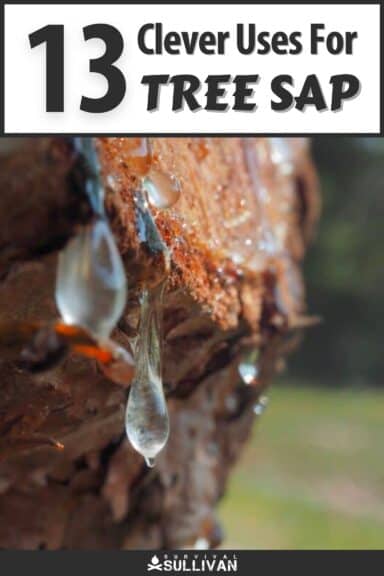One of the best things you can do to get prepared for any eventuality is to learn how to make the best possible use of all the resources around you, including those that you might overlook in other times.

Let’s look at tree sap for instance.
I think every prepper and camper understands the importance of trees and the wood they provide for building a fire, but how about the literal ‘blood’ of a tree, the sap? What can we use tree sap for?
Tree sap can be used for many different purposes, including as a sweetener for food or for making beverages, for treating injuries and skin conditions, as glue, sealant, fuel, and a lot more.
Sap, be it maple, birch, pine or something else is incredibly versatile and everyone would be well served by learning all of the different things you can do with.
It’s also something that has been used and documented for well over a thousand years by various Eurasian peoples.
Whether you’re just out camping, taking care of crafts the old fashioned way, or in the middle of a desperate survival situation sap will always have something to offer you.
Keep reading and I’ll tell you all about some of these uses down below.
1. Syrup
Tree sap is perhaps most known for its ability to be transformed into delectable syrups.
The most well-known of these is undoubtedly maple syrup, certainly the most beloved topping for pancakes and waffles.
However, other tree saps also have the potential to become sweeteners.
For instance, birch syrup, derived from the sap of birch trees, offers a unique flavor profile that’s both sweet and slightly savory.
Similarly, the sap from palm trees can be boiled down into palm syrup, which is most notably used in Asian and some African cuisine.
These diverse syrups can not only serve you as delicious toppings but also as essential ingredients in lots of different dishes.
2. Sealant
Tree sap has exceptional qualities as a sealant. It forms a natural barrier that effectively keeps out dirt, oils, and moisture.
Pine sap, for instance, has been historically used as a sealant for all kinds of tools and even structures.
When heated and then applied, it hardens to form a protective layer almost like a shell or skin.
This property of the sap makes it invaluable any time you are crafting or repairing something and need to maintain the integrity of materials, shelters and tools against environmental elements.
3. Glue
You already know how super-sticky sap is, and so it’s no wonder at all that tree sap serves as an excellent all-natural adhesive.
American Indian tribes, recognizing this property, utilized sap extensively as an adhesive in tool-making and construction.
They often mixed it with other materials to enhance its binding capabilities. Similarly, other cultures around the world found uses for sap as a glue.
Whether it’s fixing a broken tool or making something totally new, tree sap proves to be an incredibly useful substance, and one you can still make use of today if you find yourself in a pinch without that tube of super glue!
4. Varnish
Tree sap has long maintained a place in the world of wood finishing as a key ingredient in various types of varnishes.
The sap, when processed and added to other ingredients, forms a hard, glossy, translucent layer that not only enhances the aesthetic appeal of the wood, but also provides a protective shield against direct wear and tear, and even UV exposure.
Since it comes directly from trees, and often the same kind of tree that supplied the wood, sap naturally bonds well with wooden surfaces.
The enhancement of texture and grain is readily apparent, and sap-based varnishes add a beautiful sheen.
From furniture to musical instruments, tree sap varnishes are just the thing to bring out the very best in your creations.
5. Waterproofing
The waterproofing quality of tree sap is nothing short of amazing: when boiled down and then applied to boats, rafts, canoes, clothing and other gear it can render anything almost totally impervious to water.
The sap forms a barrier that repels water, keeping the underlying material dry even when exposed to heavy downpours or when floating directly on a body of water.
This unique property of tree sap makes it an indispensable natural resource for many outdoor and maritime activities when you lack other materials and coatings.
Plus, it’s one of the few things in nature you can depend on to provide durable waterproofing for just about anything that needs it when you’re in a jam.
6. Skin Treatment
Tree sap has several surprising medicinal and therapeutic qualities that can benefit you, and these qualities extend to skin treatment as well.
Traditional medicine systems have long recognized sap’s potential in relieving pain and itchiness associated with various skin conditions like eczema, bug bites, and nasty stings.
Applying sap to your sore spots can soothe inflammation and accelerate the recovery process whenever your skin is red and angry, no matter if it’s a mild irritation or a chronic skin ailment.
Tree sap has been a go-to remedy in many cultures, and can offer you natural and effective itch and pain relief today.
7. Antiseptic
Another medical use, tree sap (especially pine sap) has strong antiseptic properties that can help you effectively eliminate germs.
This quality makes it an invaluable resource in situations where conventional medical supplies are unavailable, especially when in the wilderness.
Fresh and uncontaminated sap can be directly applied to your cleaned cuts, scrapes, or penetrating injuries to help prevent infection.
This natural disinfecting power of tree sap can offer you a practical and readily accessible cleanser for treating wounds in austere environments, and is one of sap’s best attributes beyond typical “crafting” uses.
8. Soap-making
The use of tree sap in soap-making is another time-honored tradition: It’s not just prized for its pleasant fragrance, but also for its cleaning properties.
Pine tar soap is perhaps the most famous and cherished among such soaps, known for its strongly bracing and distinctive aroma, and has an added benefit for soothing irritated skin that has been put through a lot.
Birch sap also finds frequent use in soap production, and though not as popular as pine tar soap it has many of the same benefits.
Sap-based soaps can help you clean up but also nourish your skin thanks to those same beneficial compounds I’ve mentioned already.
9. Fire Starting
The flammable nature of tree sap makes it an excellent aid for starting fires wherever you happen to be, but especially in outdoor settings when you might lack other fire starters.
You can ignite most types of tree sap quickly and will find that they burn intensely, providing you a reliable way to get kindling going or even as a source of heat and light itself.
Coupled with its water-repellent characteristics, this makes tree sap one of your best options when desperately trying to get a flame to catch damp or cold conditions.
Tree sap can help turn a small spark into a roaring flame, making survival in the wilderness just a little bit easier for you.
Even better: the stuff will be all around you in most regions!
10. Lamp and Torch Fuel
Tree sap’s consistency, combustible nature and ready flammability has made it a reliable fuel source for lamps and torches throughout history.
Different types of tree sap, when ignited, will burn steadily and safely within the confines of a traditional lamp or when affixed with some cloth to the head of a torch.
Using even a small lump of blob of sap can provide you with a consistent flame for a considerable duration, making sap a good secondary fuel you can collect easily enough when processing firewood.
Whether as a primary fuel source or a backup to other, better fuel options, tree sap can illuminate your campsite, home or travels.
11. Insect Repellent
Ironically, despite being all around biting bugs in nature, many insects are repelled by tree sap.
With the right approach, you can use tree sap to deter insects from your body or campsite.
Burning tree sap can help keep insects at bay due to its propensity to create profuse smoke while also infusing the smoke with insect-repulsing compounds.
But if you are braving hordes of bloodsuckers directly, smearing tree sap on the skin can provide a sticky but effective barrier to these biting scumbags, making it an effective-but-messy natural insect repellent.
12. Chewing Gum
Culinarily, tree sap isn’t just useful for making ingredients; it can also be edible directly! While it may not be the most appetizing choice, most types of tree sap are completely safe to consume directly from the tree in small quantities.
Chewing on a small wad of sap can serve as a pastime activity if you are bored or anxious and even aid in oral hygiene.
Sap can leave your teeth feeling cleaner and your breath fresher, much like your usual chewing gum- even if it doesn’t taste as nice!
This unique use of tree sap might not be a lifesaver, but it is nice to know.
13. Beverage Making
One of my favorite uses for tree sap, it can serve as a fascinating ingredient in creating several totally unique drinks.
Birch beer, a “cousin” of sorts to root beer, is one such drink that gained immense popularity in the early part of last century.
Primarily made from the sap of birch trees, it offers a refreshing twist on traditional soft drinks.
And of course, in addition to non-alcoholic drinks, tree sap also plays a role in the production of various alcoholic beverages around the world, usually by fermenting it directly to produce distinctive liquors.
From palm wine and maple liqueur to birch vodka and birch beer, there are more sap-based drinks out there than you might think, and that means tree sap can be a valuable resource if you are brewing or distilling at home when other ingredients may be unavailable.


Tom Marlowe practically grew up with a gun in his hand, and has held all kinds of jobs in the gun industry: range safety, sales, instruction and consulting, Tom has the experience to help civilian shooters figure out what will work best for them.
